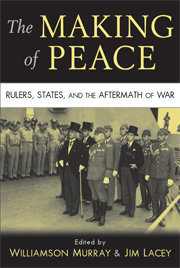Book contents
- Frontmatter
- Contents
- Preface: concluding peace
- 1 Introduction: searching for peace
- 2 The Peace of Nicias
- 3 “A swift and sure peace”: the Congress of Westphalia 1643–1648
- 4 The Peace of Paris, 1763
- 5 In search of military repose: the Congress of Vienna and the making of peace
- 6 War and peace in the post–Civil War South
- 7 Vae victoribus: Bismarck's quest for peace in the Franco-Prussian War, 1870–1871
- 8 Versailles: the peace without a chance
- 9 “Building buffers and filling vacuums”: Great Britain and the Middle East, 1914–1922
- 10 Mission improbable, fear, culture, and interest: peace making, 1943–1949
- 11 The economic making of peace
- 12 Ending the Cold War
- 13 Conclusion: history and the making of peace
- Index
- References
9 - “Building buffers and filling vacuums”: Great Britain and the Middle East, 1914–1922
Published online by Cambridge University Press: 05 June 2012
- Frontmatter
- Contents
- Preface: concluding peace
- 1 Introduction: searching for peace
- 2 The Peace of Nicias
- 3 “A swift and sure peace”: the Congress of Westphalia 1643–1648
- 4 The Peace of Paris, 1763
- 5 In search of military repose: the Congress of Vienna and the making of peace
- 6 War and peace in the post–Civil War South
- 7 Vae victoribus: Bismarck's quest for peace in the Franco-Prussian War, 1870–1871
- 8 Versailles: the peace without a chance
- 9 “Building buffers and filling vacuums”: Great Britain and the Middle East, 1914–1922
- 10 Mission improbable, fear, culture, and interest: peace making, 1943–1949
- 11 The economic making of peace
- 12 Ending the Cold War
- 13 Conclusion: history and the making of peace
- Index
- References
Summary
If the peace which the victorious powers imposed on the Middle East at the end of the First World War has not stood the test of time, the fault lies only partly with those who made it. How long a peace lasts is to some degree a function of the skills and foresight of its constructors, but sooner or later the currents of history, which one cannot reasonably have expected its architects to foresee, undermine every such construction.
The shape of the Middle East that emerged as a consequence of the world war, and its degree of stability, was a function of the interactions among three dimensions of peace making. The first, which was difficult to master, was circumstance. The turmoil which the war caused in the international power system made the shaping of medium- and long-term policy extremely difficult while imparting a commanding urgency to the short term.
The second dimension, which statesmen might have managed better, was process. Making policy was the business of a machine with multiple moving parts – a Rubik's cube of competing agencies and forceful individuals, whose activities never combined to show a uniform face. The third dimension, least understood by contemporaries, was local context. Peace making between warring states had once been a matter of drawing new maps of power. The maintenance of peace in a region, where religious beliefs were complex, social structures primitive by European standards, and polities in the sense familiar to the peacemakers effectively nonexistent, required a level of cultural understanding that far surpassed what European statesmen, diplomats, and soldiers had hitherto needed.
- Type
- Chapter
- Information
- The Making of PeaceRulers, States, and the Aftermath of War, pp. 240 - 264Publisher: Cambridge University PressPrint publication year: 2008



